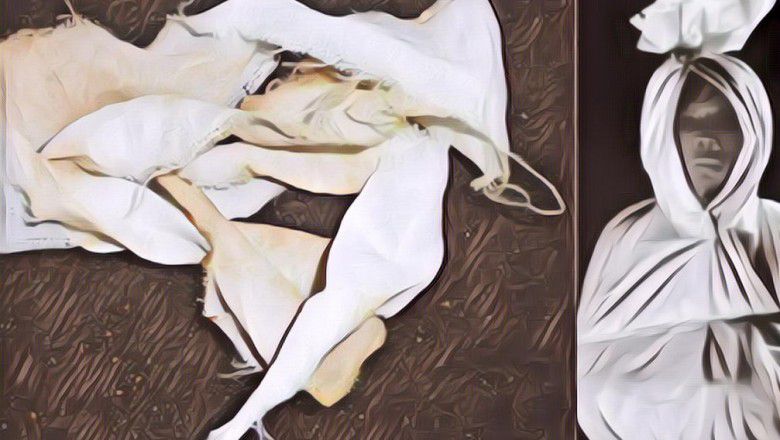
when Horror Yearbook – The Mystery Behind the Pocong Rope has intrigued many for generations. This eerie and unsettling legend from Indonesian folklore continues to capture the imagination of people. The Pocong, often described as a ghostly figure wrapped in a burial shroud, is one of the most famous supernatural beings in Southeast Asia. The rope associated with it, known as the Tali Pocong, adds to the chilling aura surrounding this figure. It is said to have ties to the afterlife, rituals, and unfinished business of the dead. Understanding this story requires an exploration into Indonesian cultural beliefs and ghostly legends.
The Pocong is a spectral figure believed to be the soul of a person who has passed away but cannot fully rest. According to tradition, after a person dies, their body is wrapped in a burial shroud called a kafan. The family ties the dead with a rope to keep the shroud in place. People say if the rope is not properly untied, the soul of the deceased cannot rest in peace. This is where the Tali Pocong comes into play.
The ghost of the Pocong often hops around due to the tightness of the burial cloth. The spirit searches for the person who failed to untie the rope before burial. The sight of a Pocong sends chills down the spine of anyone who encounters it. The legend combines cultural practices, spiritual beliefs, and the fear of death and what lies beyond.
“Read about: The Cursed Doll: A Tale of Unsettling Horror”
The Tali Pocong plays a central role in the lore surrounding the Pocong. This rope, tied around the deceased’s shroud, represents the unfinished business of the deceased. It symbolizes the soul’s inability to move on due to loved ones failing to perform the final burial rites correctly. The Tali Pocong is not just a simple rope; it symbolizes the soul’s entrapment between the living world and the afterlife.
In some versions of the story, people say the Tali Pocong is a curse. If someone unties the rope of the Pocong before its proper time, they believe it brings misfortune or even death. Others claim the Tali Pocong has the power to bind the spirit of the dead to the world of the living, forcing it to return and haunt the living until it is freed. The fear of this rope runs deep in Indonesian culture, as it connects both the inevitability of death and the consequences of ignoring important burial rituals.
The Mystery Behind the Pocong Rope reveals a lot about Indonesian beliefs regarding death and the afterlife. The practice of wrapping the deceased in a shroud and tying it with a rope is deeply rooted in Islamic funeral traditions. However, over time, these traditions have evolved into the chilling tale of the Pocong, blending both religious and supernatural beliefs.
In Indonesian folklore, the story of the Pocong and the Tali Pocong is often used as a cautionary tale. It reminds people to perform proper burial rites and show respect for the deceased. In many rural areas, belief in the Pocong remains strong. People are often cautious when dealing with burial rites, especially if they are unfamiliar with the customs.
The Pocong and its rope also represent the concept of unfinished business. People say those who die with unresolved issues or unfulfilled promises are more likely to return as a Pocong. This idea resonates with many, reflecting the fear that we may not have closure in our lives. The presence of the Tali Pocong in these stories emphasizes the importance of closure and the fear of being trapped in a state of unrest after death.
“Read more: 84 Indonesian Workers Rescued from Myanmar Scam Centers Return Home”
The legend of the Tali Pocong has inspired numerous movies, TV shows, and books in Indonesia. The fear surrounding the Pocong has made it a popular subject in horror films. The ghostly figure of the Pocong, with its haunting stare and rope-bound body, is a symbol of terror. Its appearance in media has helped perpetuate the mystery of the Tali Pocong. This makes it one of the most iconic ghosts in Southeast Asian folklore.
The Tali Pocong has also been explored in various forms of art. These include paintings and short stories. Its portrayal as a ghostly figure tied to the afterlife adds to its allure. It taps into universal fears of death and the unknown. In these depictions, the Tali Pocong is shown as a warning. This warning is for those who neglect death rituals or their responsibilities to the deceased.
The Mystery Behind the Pocong Rope continues to captivate audiences because it taps into deep-seated fears. It combines elements of religion, folklore, and the supernatural. These elements create a feeling that is both familiar and terrifying. The Tali Pocong is not just a physical object; it represents the soul’s journey. It symbolizes the fear of death and the need for closure.
While modern interpretations of the Pocong may differ, the core of the legend remains the same. It serves as a reminder to honor the dead. It urges people to fulfill burial rites and respect the boundary between the living and the dead. The Tali Pocong’s continued relevance in Indonesian culture speaks to its enduring power. It remains a strong symbol of the supernatural and the afterlife.